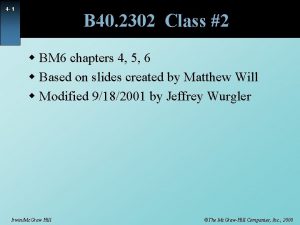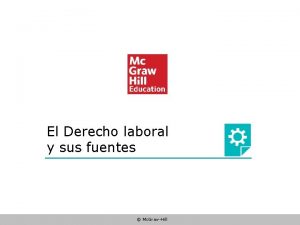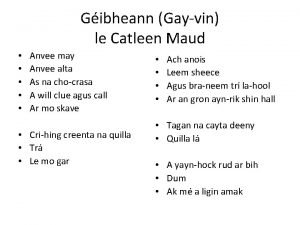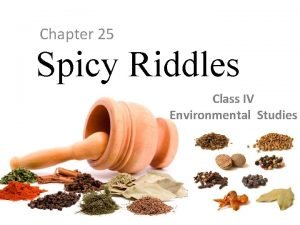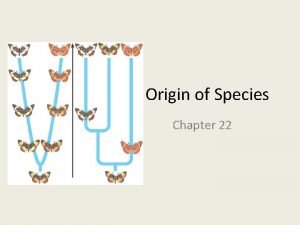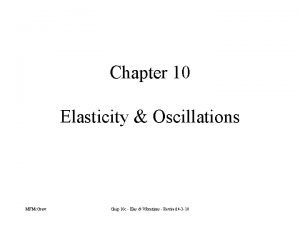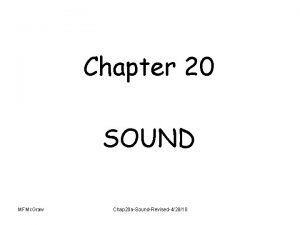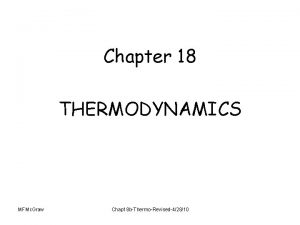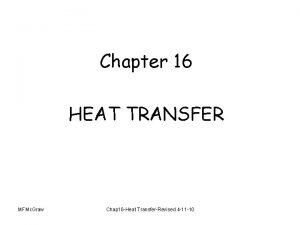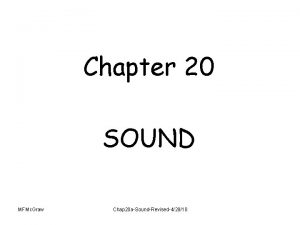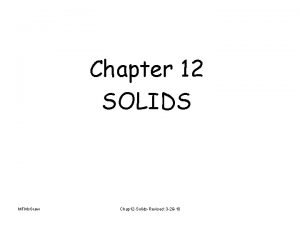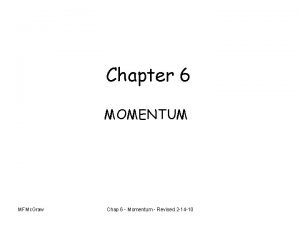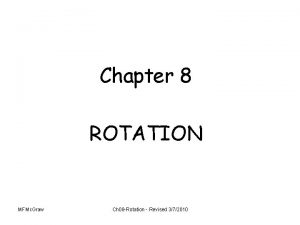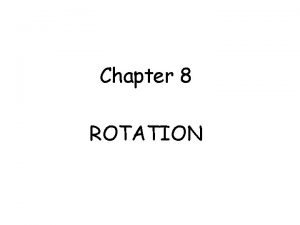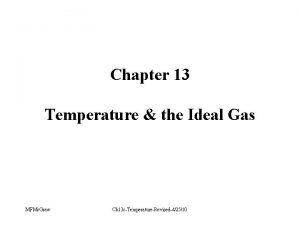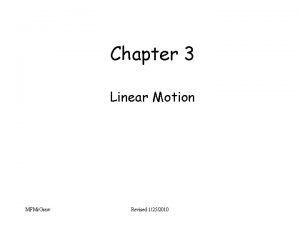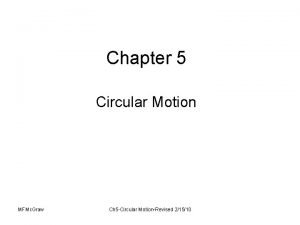Chapter 21 MUSICAL SOUNDS MFMc Graw Chap 21










































- Slides: 42

Chapter 21 MUSICAL SOUNDS MFMc. Graw Chap 21 c-Musical Sounds-Revised 5/2/10

This lecture will help you understand: • • MFMc. Graw Noise and Musical Sounds Pitch Sound Intensity and Loudness Quality Musical Instruments Fourier Analysis Digital Versatile Discs (DVDs) Chap 21 c-Musical Sounds-Revised 5/2/10

Noise • Noise corresponds to an irregular vibration of the eardrum produced by some irregular vibration in our surroundings, a jumble of wavelengths and amplitudes. – White noise is a mixture of a variety of frequencies of sound. This is similar to white light being composed of all the colors in the visible spectrum. MFMc. Graw Chap 21 c-Musical Sounds-Revised 5/2/10

Music • Music is the art of sound and has a different character. • Musical sounds have periodic tones–or musical notes. • The line that separates music and noise can be thin and subjective. MFMc. Graw Chap 21 c-Musical Sounds-Revised 5/2/10

Musical Sounds Musical tone • Three characteristics: – Pitch • determined by frequency of sound waves as received by the ear • determined by fundamental frequency, lowest frequency – Intensity • determines the perceived loudness of sound MFMc. Graw Chap 21 c-Musical Sounds-Revised 5/2/10

Musical Sounds Musical tone • Three characteristics (continued): – Quality • determined by prominence of the harmonics • determined by presence and relative intensity of the various partials MFMc. Graw Chap 21 c-Musical Sounds-Revised 5/2/10

Pitch • Music is organized on many different levels. Most noticeable are musical notes. • Each note has its own pitch. We can describe pitch by frequency. – Rapid vibrations of the sound source (high frequency) produce sound of a high pitch. – Slow vibrations (low frequency) produce a low pitch. MFMc. Graw Chap 21 c-Musical Sounds-Revised 5/2/10

Pitch • Musicians give different pitches different letter names: A, B, C, D, E, F, G. – Notes A through G are all notes within one octave. – Multiply the frequency on any note by 2, and you have the same note at a higher pitch in the next octave. – A piano keyboard covers a little more than seven octaves. MFMc. Graw Chap 21 c-Musical Sounds-Revised 5/2/10

A Note by Any Other Name. . . Source: http: //en. wikipedia. org/wiki/C_%28 musical_note%29 MFMc. Graw Chap 21 c-Musical Sounds-Revised 5/2/10

Pitch • Different musical notes are obtained by changing the frequency of the vibrating sound source. • This is usually done by altering the size, the tightness, or the mass of the vibrating object. MFMc. Graw Chap 21 c-Musical Sounds-Revised 5/2/10

Pitch • High-pitched sounds used in music are most often less than 4000 Hz, but the average human ear can hear sounds with frequencies up to 18, 000 Hz. – Some people and most dogs can hear tones of higher pitch than this. – The upper limit of hearing in people gets lower as they grow older. – A high-pitched sound is often inaudible to an older person and yet may be clearly heard by a younger one. MFMc. Graw Chap 21 c-Musical Sounds-Revised 5/2/10

Sound Intensity and Loudness • The intensity of sound depends on the amplitude of pressure variations within the sound wave. • The human ear responds to intensities covering the enormous range from 10– 12 W/m 2 (the threshold of hearing) to more than 1 W/m 2 (the threshold of pain). MFMc. Graw Chap 21 c-Musical Sounds-Revised 5/2/10

Sound Intensity and Loudness • Because the range is so great, intensities are scaled by factors of 10, with the barely audible 10– 12 W/m 2 as a reference intensity called 0 bel (a unit named after Alexander Bell). • A sound 10 times more intense has an intensity of 1 bel (10– 11 W/m 2) or 10 decibels (d. B) MFMc. Graw Chap 21 c-Musical Sounds-Revised 5/2/10

Sound Intensity and Loudness • Sound intensity is a purely objective and physical attribute of a sound wave, and it can be measured by various acoustical instruments. • Loudness is a physiological sensation. – The ear senses some frequencies much better than others. – A 3500 -Hz sound at 80 decibels sounds about twice as loud to most people as a 125 -Hz sound at 80 decibels. – Humans are more sensitive to the 3500 -Hz range of frequencies. MFMc. Graw Chap 21 c-Musical Sounds-Revised 5/2/10

The Threshold of Hearing The decibel scale MFMc. Graw Chap 21 c-Musical Sounds-Revised 5/2/10

The Decibel Scale MFMc. Graw Chap 21 c-Musical Sounds-Revised 5/2/10

Quality • We have no trouble distinguishing between the tone from a piano and a tone of the same pitch from a clarinet. • Each of these tones has a characteristic sound that differs in quality, the “color” of a tone — timbre. • Timbre describes all of the aspects of a musical sound other than pitch, loudness, or length of tone. MFMc. Graw Chap 21 c-Musical Sounds-Revised 5/2/10

Quality • Most musical sounds are composed of a superposition of many tones differing in frequency. • The various tones are called partial tones, or simply partials. The lowest frequency, called the fundamental frequency, determines the pitch of the note. • A partial tone whose frequency is a whole-number multiple of the fundamental frequency is called a harmonic. MFMc. Graw Chap 21 c-Musical Sounds-Revised 5/2/10

Quality • A composite vibration of the fundamental mode and the third harmonic is shown in the figure. MFMc. Graw Chap 21 c-Musical Sounds-Revised 5/2/10

Quality • The quality of a tone is determined by the presence and relative intensity of the various partials. • The sound produced by a certain tone from the piano and a clarinet of the same pitch have different qualities that the ear can recognize because their partials are different. • A pair of tones of the same pitch with different qualities have either different partials or a difference in the relative intensity of the partials. MFMc. Graw Chap 21 c-Musical Sounds-Revised 5/2/10

Musical Instruments Vibrating strings – Vibration of stringed instruments is transferred to a sounding board and then to the air. Vibrating air columns – Brass instruments. – Woodwinds—stream of air produced by musician sets a reed vibrating. – Fifes, flutes, piccolos—musician blows air against the edge of a hole to produce a fluttering stream. MFMc. Graw Chap 21 c-Musical Sounds-Revised 5/2/10

Musical Instruments Percussion – Striking a 2 -dimensional membrane. – Tone produced depends on geometry, elasticity, and tension in the vibrating surface. – Pitch produced by changes in tension. MFMc. Graw Chap 21 c-Musical Sounds-Revised 5/2/10

Musical Instruments Electronic musical instrument • differs from conventional musical instruments • uses electrons to generate the signals that make up musical sounds • modifies sound from an acoustic instrument • demands the composer and player demonstrate an expertise beyond the knowledge of musicology MFMc. Graw Chap 21 c-Musical Sounds-Revised 5/2/10

Fourier Analysis • The sound of an oboe displayed on the screen of an oscilloscope looks like this. • The sound of an clarinet displayed on the screen of an oscilloscope looks like this. • The two together look like this. MFMc. Graw Chap 21 c-Musical Sounds-Revised 5/2/10

Fourier Analysis • Fourier discovered a mathematical regularity to the component parts of periodic wave motion. • He found that even the most complex periodic wave motion can be disassembled into simple sine waves that add together. • Fourier found that all periodic waves may be broken down into constituent sine waves of different amplitudes and frequencies. • The mathematical operation for performing this is called Fourier analysis. MFMc. Graw Chap 21 c-Musical Sounds-Revised 5/2/10

Fourier Analysis • When these pure tones are sounded together, they combine to give the tone of the violin. • The lowest-frequency sine wave is the fundamental and determines the pitch. • The higher-frequency sine waves are the partials that determine the quality. • Thus, the waveform of any musical sound is no more than a sum of simple sine waves. MFMc. Graw Chap 21 c-Musical Sounds-Revised 5/2/10

Wave Components in Frequency Space Fourier Analysis MFMc. Graw Chap 21 c-Musical Sounds-Revised 5/2/10

Musical Instruments Frequency Components MFMc. Graw Chap 21 c-Musical Sounds-Revised 5/2/10

Musical Instrument Waveforms Violin MFMc. Graw Trumpet Chap 21 c-Musical Sounds-Revised 5/2/10 Clarinet

Frequency Component Structure Violin Clarinet Organ Pipes Piano MFMc. Graw Chap 21 c-Musical Sounds-Revised 5/2/10

Typical Musical Overtone Structures MFMc. Graw Chap 21 c-Musical Sounds-Revised 5/2/10

Fourier Analysis Tool http: //www. austincc. edu/mmcgraw/physics_simulations. htm MFMc. Graw Chap 21 c-Musical Sounds-Revised 5/2/10

Standing Wave Patterns MFMc. Graw Chap 21 c-Musical Sounds-Revised 5/2/10

Ringing Bell - Resonant Modes MFMc. Graw Chap 21 c-Musical Sounds-Revised 5/2/10

Guitar - Resonant Modes MFMc. Graw Chap 21 c-Musical Sounds-Revised 5/2/10

Digital Versatile Discs (DVDs) MFMc. Graw Chap 21 c-Musical Sounds-Revised 5/2/10

Digital Versatile Discs (DVDs) • The signal below is the output of a phonograph. • This type of continuous waveform is called an analog signal. • The analog signal can be changed to a digital signal by measuring the numerical value of its amplitude during each split second. MFMc. Graw Chap 21 c-Musical Sounds-Revised 5/2/10

Digital Versatile Discs (DVDs) • Microscopic pits about one-thirtieth the diameter of a strand of human hair are imbedded in the CD or DVD – The short pits corresponding to 0. – The long pits corresponding to 1. MFMc. Graw Chap 21 c-Musical Sounds-Revised 5/2/10

Digital Versatile Discs (DVDs) • When the beam falls on a short pit, it is reflected directly into the player’s optical system and registers a 0. • When the beam is incident upon a passing longer pit, the optical sensor registers a 1. • Hence the beam reads the 1 and 0 digits of the binary code. MFMc. Graw Chap 21 c-Musical Sounds-Revised 5/2/10

DVD vs Blu-Ray Single layer storage comparison MFMc. Graw Chap 21 c-Musical Sounds-Revised 5/2/10

DVD vs Blu-Ray DVD Blu-Ray λ = 650 nm λ = 405 nm MFMc. Graw Chap 21 c-Musical Sounds-Revised 5/2/10

Summary • • MFMc. Graw Noise and Musical Sounds Pitch Sound Intensity and Loudness Quality Musical Instruments Fourier Analysis Digital Versatile Discs (DVDs) Chap 21 c-Musical Sounds-Revised 5/2/10
 Chap chap slide
Chap chap slide A combination of two vowel sounds
A combination of two vowel sounds Oral sounds and nasal sounds
Oral sounds and nasal sounds What is flaw graw
What is flaw graw Operations definition
Operations definition Freshwater ecosystems are classified as
Freshwater ecosystems are classified as Graw print
Graw print Monroe's motivated sequence example
Monroe's motivated sequence example Suzanne graw
Suzanne graw Mc graw hill education
Mc graw hill education Mc graw hill education
Mc graw hill education Area principle statistics
Area principle statistics Fuentes internas y externas del derecho laboral
Fuentes internas y externas del derecho laboral Mc graw hill education
Mc graw hill education Mc grawhill
Mc grawhill Faw graw
Faw graw Mc graw hill
Mc graw hill Flaw graw
Flaw graw Retail positioning matrix
Retail positioning matrix Define graw
Define graw Graw outlet
Graw outlet Style chapter 1
Style chapter 1 Passion chap 6
Passion chap 6 Bank run chap 11
Bank run chap 11 Autocorrelation ppt gujarati
Autocorrelation ppt gujarati Red chilli riddles
Red chilli riddles Kstn chap 18
Kstn chap 18 Characteristics of family
Characteristics of family Origin of species manga chapter 24
Origin of species manga chapter 24 Satisfying needs 2
Satisfying needs 2 The origin of species chapter 22 yaoi
The origin of species chapter 22 yaoi Mad dog ch25
Mad dog ch25 Matthew chapter 5
Matthew chapter 5 Child development chapter 1
Child development chapter 1 Rivalry 1 chapter 6
Rivalry 1 chapter 6 System engineer chap 1
System engineer chap 1 Chap tree
Chap tree Tree switch
Tree switch I was in that state when a chap easily turns nasty analysis
I was in that state when a chap easily turns nasty analysis The origin of species chap 24
The origin of species chap 24 Passion chapter 9
Passion chapter 9 đường bao của mặt cắt chập được vẽ bằng
đường bao của mặt cắt chập được vẽ bằng In the summer chap 22
In the summer chap 22



